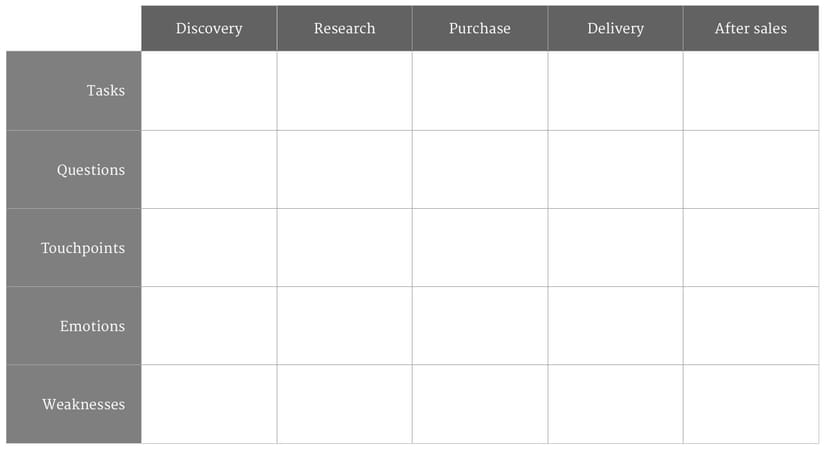Customer Journey Mapping

Customer journey mapping is an excellent tool to use for visualizing the customer’s experience with your business. It is a visual representation of every experience or touchpoint that your customers have with you and should be representative of a typical experience. It helps to tell the story of a customer's experience from the original interest through to engagement and into a long-term relationship.
Ultimately, the customer journey map will demonstrate where your business is failing to meet the needs and expectations of your customers. It will help you to focus on your customer, rather than on your products, services and organization.
Customer Journey Mapping and Your Buyer Personas
Customer journey maps work in synergy with your pre-defined buyer personas. Buyer personas are semi-fictional representations of your ideal customer based on market research and real data about your existing customers. The biggest difference is that a customer journey map focuses more on tasks and questions that your customer might have. They also express your customer’s experience over time, rather than as a snapshot. A buyer persona focuses on the person, while a customer journey map focuses on their experience and how your customers move through the sales funnel.
Observing how your customers move through the sales funnel will help you identify opportunities to enhance their experience and eliminate any potential gaps. Any gap should get your immediate attention as gaps in the journey are often where customers slip away or lose interest. For example, you might notice the following:
- Gaps between devices. Does the information appear the same on a phone as it does on a computer. Is it easy to pick up the journey on a different device?
- Gaps between departments. Is it easy to move from one department to another.
- Gaps between channels. Can you move seamlessly from social media to your website.
- Gaps in content. Are you answering every question that your clients might have?
To make your map as useful as possible, you will need to think about every point where your customers come into contact with your business. Your customers can come into contact with your business in a number of different ways. For example, clients might hear about you via marketing, referrals, search, social networks, social media, online review sites, customer service enquiries, trade shows, manuals, packaging, webinars, etc. To make sure that every customer gets the proper attention, you need to map out every touchpoint along the customer journey.
This is also an ongoing reminder that throughout the creation of the map you must always consider the user’s context. The user’s questions, feelings and goals will change throughout their journey. You need to be aware of that.
Identify the Principal Stages of User Interaction
But, how to map a customer journey? The first thing you need to do is to identify the principal stages a customer passes through in their interaction with your company. The basic stages are:
1. Discovery
At this stage, your future customers are first starting to think that they need to find a solution to some issue in their life. The issue could be anything from a recent wedding invitation to dreading a long commute to work to noticing that their contact list is disorganized.
2. Research
Once they have identified the issues they would like to resolve, they start to research possible solutions. What can I wear to the wedding? What kind of present should I buy? Will public transport be faster? What kind of software will organize my contacts?
3. Decision
After a decision has been made on what solution best solves the current problem, the customer might do some price comparison or canvas different suppliers. How can I get the best deal? Who is the most reliable solution provider?
4. Purchase
The purchase stage can be done in a variety of ways. People may purchase online, over the phone, or in person. Remember, this stage must be very easy for the customer. How can I purchase this solution? What methods of payment do they accept?
5. Delivery
The solution gets delivered to the purchaser. How will it be delivered? Do I need it delivered by a certain date? Is there a delivery guarantee? Delivery might be a download, collection at a store, delivered by post, or delivered by a truck.
6. After Sale
The period after the sale is the most overlooked stage. Where can I ask questions? What if the solution does not work? How can I upgrade?
Some customer journey maps even branch into sub-journeys or double back on themselves. But try not to make it too complicated. A customer journey map is telling a story.
Identify the Information You Want to Map
Once you have identified the principal stages, you will need to figure out what information you want to map about the user at each stage. We outlined some questions above for illustration but you should create your own framework. Think about the following information when you are creating your customer journey map:
- Tasks. What is the customer trying to achieve at this stage? There will always be more than one task although one task might be primary.
- Questions. What does the customer want to know at this stage? We illustrated some questions but there are dozens more that you could include.
- Touchpoints. How does the user interact with your company at this point? Online, in-person, or over the phone? Or, are they reading about you online? Research indicates that the number of customer touchpoints is increasing by approximately 20% year over year.
- Emotions. What is the customer feeling at this stage in the process? This will change as they go through the journey.
- Weaknesses. Where do we drop the ball? Where can you do better at this stage?
- Influences. Who or what is helping to shape the customer’s decision-making process at this stage?
Create Your Customer Journey Grid
Once you have identified the principal stages of the journey and the information that you want to map, you can create a simple grid. The grid is best completed by workshopping with others on your team. Put your ideas on post-it notes and get creative. Post-it notes work the best as you will likely end up moving the ideas around.
An example of a grid for your customer journey map template is below:

It is important to note that the questions your customer might have will vary depending on the nature of your product or service. There is no right or wrong way to organize your stages so feel free to vary the map over time. The goal is to ensure that the user’s story remains central. It should highlight users’ needs, questions and feelings throughout their interaction with the organization.
Once you have brainstormed and collected all of the relevant information, you can start to plot your map. There is no right or wrong way to produce a customer journey map example. Typically, it will be some form of infographic with a timeline of the user’s experience. If possible, get a designer to produce the graphic to ensure that it is as understandable as possible and grabs people’s attention. It could also be a storyboard or even a video. Think of the customer journey map as a poster. Your team should be able to quickly see the critical touchpoints that your customers encounter. If you don't have the resources to create something fancy you will still be well served with a basic customer journey map.
Is your customer journey an easy or stressful experience?
The best way to figure that out is by customer journey mapping. Mapping out their journey and the experiences your customers are having with your business will provide you with the insight you need to improve. Failing to put effort into this project creates a risk of losing potential customers.
If you still have questions about how to map a customer journey, please give us a call.
